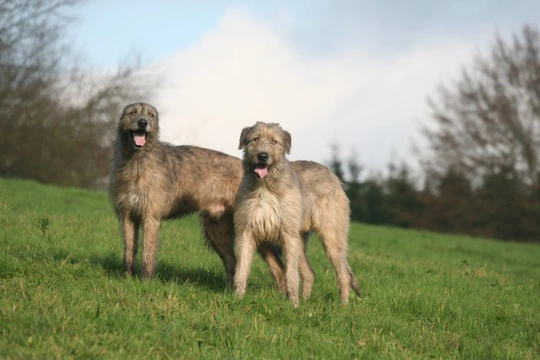
Six interesting facts about the Irish wolfhound
The Irish wolfhound is an incredibly tall dog that is not among the most common that you will see out and about in the UK, but once you have seen one, you will never forget them! They fall into the hound grouping for showing and breeding purposes, and are one of the sighthound breeds-dog breeds that hunt by sight rather than scent. Like all sighthounds, they are long legged and lean, with a truly impressive turn of speed when on the chase, making them able to catch up to even the fastest potential prey.
Due to their rather imposing size, many people that admire the Irish wolfhound cannot really accommodate one, as a large, rangy dog needs a lot of space, and all of their accessories and equipment need to be supersized too, from their beds to their food bowls! However, despite their imposing appearance and very loud, rumbling bark, the Irish wolfhound is a gentle giant that is extremely personable and affectionate, and very gentle.
If you are considering adopting or buying an Irish wolfhound or are simply interested in the breed, you have probably spent some time looking into the core traits of the breed and what they are like to live with, as well as their origins and history. In this article, we will share six interesting facts about the Irish wolfhound dog breed that you might not already know. Read on to learn more!
They are one of the world’s tallest dog breeds
First up, the Irish wolfhound is one of the world’s tallest recognised dog breeds, but because of their lean build, they don’t rank in the top five on weight and bulk alone. The average Irish wolfhound stands up to around 34” tall at the shoulder, and when larger dogs of the breed stand up on their hind legs, they can reach over seven feet tall-taller than their owners!
While the world record for the tallest dog is currently held by a Great Dane, Irish wolfhounds come in a close second, and many Irish wolfhounds are taller than all but the tallest of Great Danes, making them real canine giants.
Despite their appearance, they are not usually good guard dogs
The Irish wolfhound does have a rather imposing appearance, thanks to their height and conformation-which leads many people to think that they would also be good guard dogs. However, while the sight of an Irish wolfhound staring at you if you are doing something that you shouldn’t be might be enough to act as a deterrent and make you think twice-and their large, rumbling barks will certainly make you pause for thought too-this is about the limits of an Irish wolfhound’s abilities as a guard dog, and they are not particularly defensive or aggressive unless trained for these traits.
They tend to be mildly inquisitive about strangers rather than wary of them, and are gentle, personable and very affectionate dogs.
They have a very long recorded history
The very earliest ancestors of the Irish wolfhound may have been brought to Ireland as far back as 7000 BC, and the breed is mentioned in Irish literature going back as far as the fifth century. Interestingly, the breed as it was back then were prized for their guarding skills, and were used to protect both homes and livestock, and dogs of the breed were valued for their bravery and fierce appearance. However, they are not naturally particularly suspicious of strangers, and are generally more interested in saying hello and trying to charm a treat out of newcomers than they are seeing them off!
They are fearless hunters
One area in which the Irish wolfhound really is unmatched in terms of their ferocity and bravery is when facing potential threats and larger animals-the breed’s name of course references this, and Irish wolfhounds were widely used to deter and see off wolves, and would successfully take on a wolf that threatened their home or livestock and win.
The breed’s large size of course helps with this, and while the Irish wolfhound is unlikely to be the type of dog that starts a fight, they may well be the one to finish it! They also have a reasonably strong prey drive, like all sighthound breeds, and so may pursue smaller prey too.
They are surprisingly lazy
Another widespread sighthound trait is that while the Irish wolfhound can reach a very fast running pace and they do like to run and stretch their legs every day, they are also fairly lazy outside of their periods of exercise! If you have a large home, the Irish wolfhound will make full use of this, stretching out and taking up half the floor or all of the sofa and spending a lot of time asleep or relaxing!
The breed nearly died out in the 19th century
During the 18th and 19th century, the native wolf populations of Ireland significantly fell in number, and so one of the main working roles for the breed became virtually obsolete. Dogs of the breed were not hugely common even at their historical peak, and as demand for them fell as the threat of wolves lessened, the Irish wolfhound breed itself almost died out at the start of the 19th century.
Only by means of concerted efforts and outcrossing to the Scottish deerhound dog breed did the Irish wolfhound survive, and naturally, this means that dogs of the breed today are slightly different to their ancestors from a couple of centuries ago.



